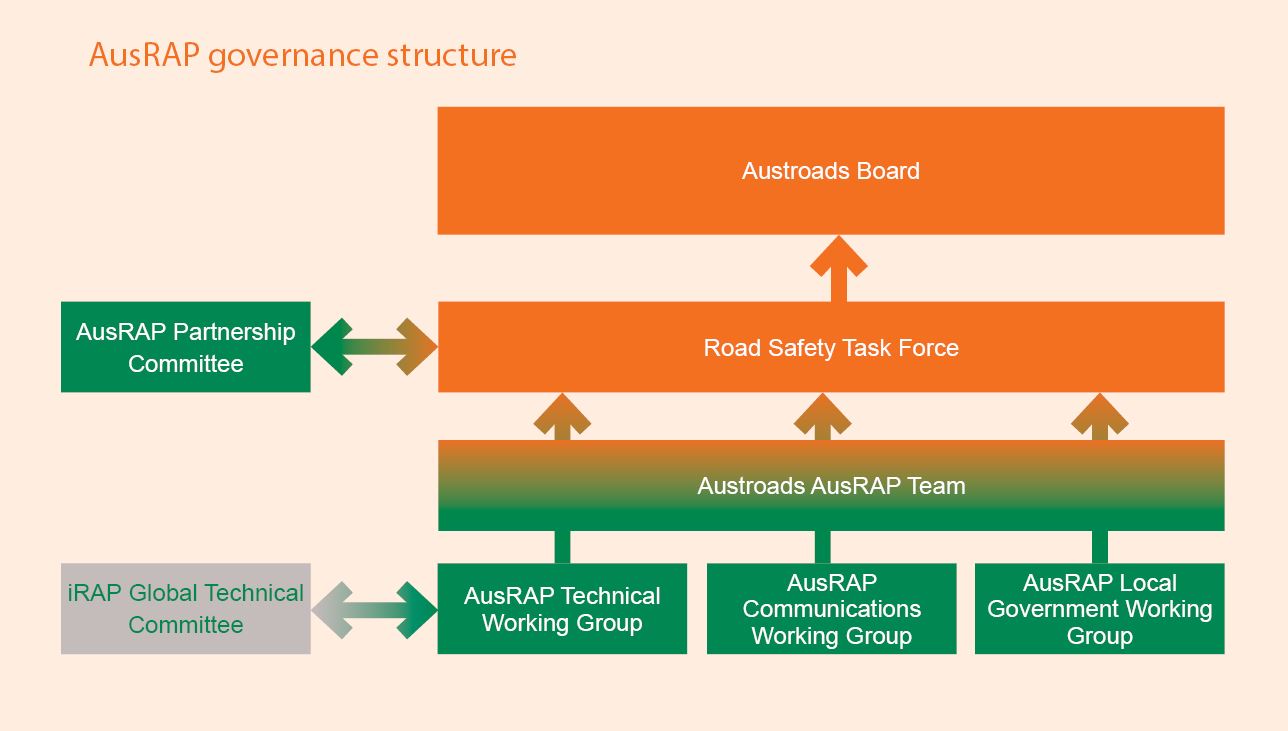This page provides details about the AusRAP Framework, including its mission and goals, governance, partnerships and other information.
Our mission: An Australia free of high-risk roads for all road users.
Our goal: By 2030, at least 80% of travel on 3-star or better roads.
Our values [STAR]: In every action and decision, the AusRAP team will prioritise and demonstrate:
- Safety culture – we prioritise safety and shared improvement
- Transparency – monitor, review, reset
- Alignment – coordinated delivery and communication
- Reputation – committed to public reporting.
Within Austroads, AusRAP is overseen by a Steering Committee which consists of the members of Road Safety Task Force (RSTF), which in turn answers to the Austroads Board. The RSTF consists of the senior road safety officials from each Australian and New Zealand road jurisdiction, the Department of Infrastructure, Transport, Regional Development, Communications and the Arts and the Australian Local Government Association. AusRAP will also be guided by the other partner organisations mentioned in the AusRAP Partnerships section, but not governed by them.
National working groups, coordinated by the AusRAP team, will be established for key components of AusRAP activities, as may be required to deliver the program plan.

As the AusRAP lead, Austroads has partnered with the Australasian College of Road Safety, the Australian Local Government Association, the Department of Infrastructure, Transport, Regional Development, Communications and the Arts, Infrastructure Australia, international Road Assessment Program, state, territory and local governments, Roads Australia and the National Transport Research Organisation.
This partnership will:
- support infrastructure planning, management and investment in safer roads for the benefit of all Australians
- work towards the target that more than 80% of travel is on 3-star or better roads for all Australian road users by 2030
- track performance and communicate (to the public and decision makers) the safety of road transport infrastructure in line with global and local road safety performance targets and the UN Decade of Action Safety Plan 2021-2030
- lift the safety capability of road managers in all jurisdictions and across all levels of government.
A Road Assessment Program (RAP) is a methodology used to identify, manage, and improve road infrastructure, roadside features and speed limits to reduce road trauma systematically and proactively.
By collecting and then coding road attribute data alongside supporting data (such as vehicle or cyclist flows), RAP users (who are often road authorities) can proactively undertake analysis to produce crash risk maps, star ratings, and network safety plans.
Crash risk mapping uses detailed crash data to produce maps showing the risk arising from the interaction of road users, vehicles and the road environment.
Star ratings are an objective measure of the level of safety ‘built-in’ to the road for vehicle occupants, motorcyclists, bicyclists, and pedestrians. Each star rating increment represents approximately half the road safety risk of the previous band.
Crash risk mapping and star ratings are key outputs that help road authorities make sound strategic investment and management decisions on road safety treatments across their networks, ultimately promoting the implementation of road safety countermeasures that can save lives.
As at 2024, there are 128 recognised RAP programs operating throughout Europe, Asia Pacific, North, Central and South America and Africa.
The International Road Assessment Program (iRAP) was established in 2006. iRAP is the umbrella organisation for road assessment programs world-wide and it facilitates the development of road assessment work in low- and middle-income countries.
The iRAP vision, which is reflected in the AusRAP vision, is a world free from high-risk roads, for all road users. iRAP works in more than 100 countries in partnership with governments, road authorities, mobility clubs, development banks, non-government and research organisations to:
- inspect high-risk roads and develop star ratings, risk maps and safer roads investment plans
- provide training, technology and support that will build and sustain national, regional and local capability
- track road safety performance so that funding agencies can assess the benefits of their investments.
The success of iRAP is evidenced by:
- More than 1.8 million km of star ratings completed across 126 countries globally (this includes star rating and investment plans on 1,560,000km of roads; 150,000km of light star ratings; 54,000km of design star ratings and over 1,300 star rating for schools assessments).
- More than 1.8 million km of iRAP risk maps completed globally (these are historical crash maps that detail fatal and serious injury crashes per kilometre and/or per kilometre travelled).
Publishing the iRAP Safety Insights Explorer, which is based on recent star rating assessments of 502,642km of data across 84 countries that have also been part of formal quality assurance processes.


